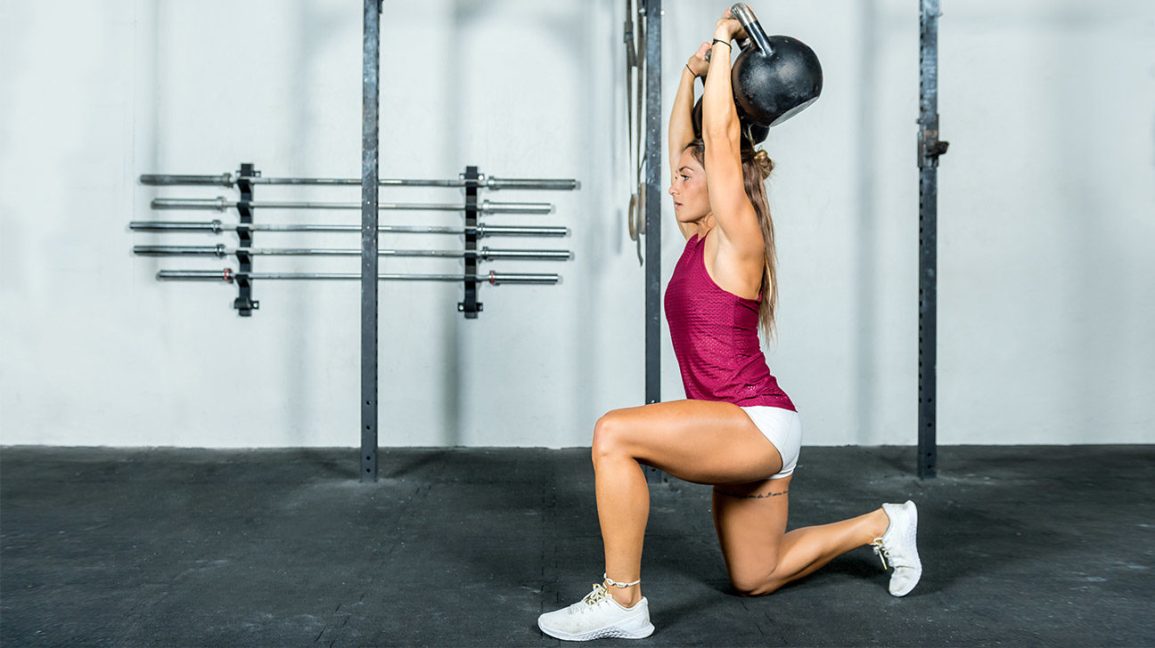Training with your own body weight. Is it enough for visible progress? Or are you giving away potential – and would you be better positioned with a couple of dumbbells?
Dumbbell training is undoubtedly one of the fastest ways to a strong body that you feel good in.
And it’s not the only way.
You can exercise your muscles properly even without equipment and without a gym.
If you follow a few simple but essential principles.
In this article you will learn how to put the principles of proper strength training into practice. By training with your own body weight.
This is a guest post by Patrick “Pat” Bauer.
Pat is a sports scientist and country manager of the Austrian popular sports association “Sportunion Burgenland”. With his blog 4yourfitness he helps people to get and stay fit.
With that I hand over to Pat.
What are bodyweight exercises?

Many fitness trends come and go. Not so training with your own body weight:
Bodyweight training is literally stuck in the “Top 3” of the hottest fitness trends in the world. 1
And since 2014. This is the result of the American Journal of Sports Medicine in its annual survey.
We have Mark Lauren to thank for bodyweight exercises to have arrived in the middle of society, who landed a timeless bestseller with his great book “Fit without equipment”.
Training with your own body weight is anything but new.
The gladiators and Spartans did. German Armed Forces, Federal Armed Forces and U.S. Marines do it. And bodyweight training is a must for gymnasts.
Even so, body weight training is still underestimated. It can help you achieve your naked-good-looking goals. In every way.
We can roughly divide bodyweight exercises into four categories. There are:
- Strength emphasized bodyweight training such as calisthenics or skill training.
- Mobility s emphasized bodyweight training such as yoga or mobility conditioning.
- Endurance emphasized bodyweight training such as freeletics, running or aerobics.
- Mixed forms such as Animal Athletics or Natural Movement.
This shows how versatile training with your own body weight can be.
What is bodyweight training anyway? Let’s define the term as follows:
Bodyweight Training summarizes all movements for which you do not need any additional equipment and which aim to maintain or increase the performance of your body.
“Increase in performance” can mean different things. It is measured by your goal.
Maybe you want to increase your strength, become more flexible, work on your speed or endurance. Maybe you are also interested in mental fitness or simply (even) more sexiness.
Bodyweight training can help you with this.
What are the advantages of training with your own body weight – and what’s the catch?

Like any form of training, bodyweight training at home (or in a hotel room) has not only advantages but also disadvantages.
Here’s a look at both sides of the coin. Let’s start with the cons.
[-] Training with your own body weight – disadvantages
- Technical requirement: You have to master the correct technique of the exercises so that you do not put the wrong strain on your joints. In many cases, the technical demands are higher than with equipment training.
- Self-motivation: Some people find it easier to go to the gym than to kick their buttocks in their own four walls.
- Progression: The resistance or the difficulty of a bodyweight exercise can usually not be changed as easily and precisely as with equipment or dumbbell training.
- Fine tuning: With With weights or machines, you can easily train individual muscles in isolation, e.g. “rework” for weak points. This is more difficult with bodyweight exercises.
- Muscle building: It is more difficult to build muscle mass with bodyweight exercises than when training with additional weights.
That’s right. Depending on the objective, these disadvantages can be more or less serious.
But look, the advantages also have it all …
[+] Training with your own body weight – advantages
- You are independent of location. 2 × 2 meters of space are sufficient in most cases.
- You are independent of the weather. You don’t care that it’s storming and snowing outside. Then you just do your training at home.
- You are independent of time. Since you don’t need more than your own body, sports clothes and possibly one Shower, you can train whenever you want: in the morning, at noon, in the evening, maybe even at night. You decide.
- You train functionally. Training with your own body weight does not address your muscles in isolation, but in their kinetic chain. Instead of individual muscles, you train movement sequences. This allows you to move more smoothly and reduce the risk of injury.
- You break down fat and look good naked. Bodyweight training is a good fat loss tool. If you combine it with high-intensity interval training, you get your metabolism going and you also save time. 2 3
- It challenges you. Whether you are an absolute beginner or a bodyweight beast: If you want, you can always go a step further.
- You become more mobile. Exercise bodyweight exercises – done correctly – always also your mobility. For example, the deep squat used to be a problem for me. Not anymore.
- You become more stable. You always train your body tension, your core and thus your stabilizing muscles. This improves your posture and possibly even your general performance. 4 5
- You control your body. In almost all bodyweight exercises, body control, coordination and balance play a role. This is especially true for one-sided (unilateral) exercises.
- Alone or in a group. Do you prefer to train alone or in a group? Fine. Both are possible when training with your own body weight.
- Variation. Do you always need variety during training? No problem. Every bodyweight exercise and every workout allows you countless variations.
- Endurance and strength endurance. At the latest when you can do 100 burpees in a row, you know that Bodyweight training can improve both at the same time. 6
Interim conclusion: bodyweight or dumbbell training?
Clearly, bodyweight training is not THE perfect training method for EVERYONE. Because that doesn’t exist.
But when you weigh the pros and cons, you can make a decision. Perhaps you have a fully equipped HomeGym, are you regularly in the gym and prefer to grab a dumbbell? Fine. Go for it!
For me, the advantages of bodyweight training outweigh them.
I love it. Because I know how to adapt it exactly to my needs and goals.
In addition, this knowledge also helps if you primarily train with additional weights. And, for example, only focus on training with your own body weight while you are traveling.
If you know the training principles in strength training, you can use them to see progress faster in bodyweight training.
The 7 elements of “correct” strength training – for bodyweight training
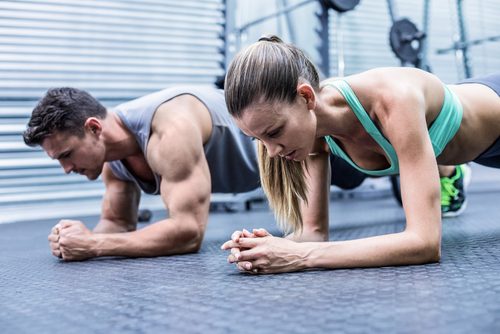
If you want to get stronger, it only means one thing:
You train and your body adapts.
Training means increasing performance. Or more generally: customization.
At the end of this process you will be stronger, tighter and – if you want – more muscular.
When we talk about muscular adaptation, we have to consider the basics of training science.
Mark summarizes these basics in his 7 principles for “proper” strength training:
- The principle of continuous overload
- The principle of training intensity
- The principle of the optimal number of repetitions
- The principle of optimal weight
- The principle of the optimal pause in sentences
- The principle of the optimal tempo
- The principle of variety
You can read here how to do it with dumbbells.
In fact, training with your own body weight must also meet these requirements if you want to make progress with it.
However, the implementation looks a little different in some points than with classic dumbbell training.
Let’s go through one principle after the other: You will learn how to put it into practice with bodyweight exercises.
1. The principle of continuous overload
What is it about? Simply put, you want to break your own records. This means that you expand your comfort zone step by step, either by conquering more resistance or by doing more repetitions.
How do you do it with dumbbells? You are trying to reach the upper limit of the given number of repetitions with a certain weight – e.g. 12 reps – getting a little closer in each workout. As soon as you can do 12 repetitions, you increase the weight and thus the resistance that your muscles are working against. Then the game starts all over again.
How do you do it with bodyweight exercises? If you train without additional weight, you cannot logically increase the resistance by adding more weight. So you have to increase it in a different way once you hit the upper reps. You can do this by making the exercise more difficult.
Case study: pushups
- Choose an exercise variant with which you can do 8 to 15 repetitions. Suppose this is the classic push-up.
- As soon as you reach the upper limit (15 reps) with clean technique, you make the exercise more difficult by placing your legs higher: e.g. on a step or bench.
- This shifts your body’s center of gravity towards your head: your arms have to cope with more resistance.
2. The principle of training intensity
What is it about? You feel the intensity of training: The more strenuous your training, the higher the intensity. You have found the right training intensity if the last 2-3 repetitions are difficult for you and your muscles are burning.
How do you do it with dumbbells? Choose a weight that will make your muscles burn nicely at the end of a training set. If you hit the upper repetition limit (for 8-12 repetitions, i.e. 12) and managed 3-4 more repetitions, the weight is too light and the intensity too low. Then you are giving away potential.
How do you do it with bodyweight exercises? When training with your own body weight, you control the resistance not with additional weight, but with the exercise itself. Choose an exercise variant that your muscles at the end of a Training set burns.
The same applies here: If you can reach the upper limit of repetitions and manage more repetitions, the intensity is too low.
You can increase the intensity in one of two ways:
- You increase the resistance by choosing a more difficult exercise variant. For example, by training a one-legged squat instead of a classic squat.
- You use a intensity technique . For example, supersets or decreasing sentences.
Excursus: weight loss sets as an intensity technique in bodyweight training
The intensity technique “decreasing sets” comes from the classic dumbbell training: You start with a heavy weight and reduce the weight with each training set. By limiting the breaks in sentences to a few seconds, you increase the intensity of an exercise.
This method can be transferred to training with your own body weight: You choose a bodyweight exercise that will cause you to fail after 10 to 15 repetitions.
Then you make the exercise a little easier and immediately do another sentence.
Finally, you choose another easier exercise variant and go again to muscle failure. This intensity technique is not suitable for all bodyweight exercises, but for everyone in which you can easily change the resistance via the position of your body (e.g. during push-ups).
3. The principle of the optimal number of repetitions
What is it about? The repetition number allows you to control the effect of the training on your muscles. The “optimal reps” is the one that is ideal for your goal setting.
How do you do it with dumbbells? You choose the weight so that you move in the rep range that meets your training goal. The higher the weight, the fewer repetitions you can do.
How do you do it with bodyweight exercises? You choose the resistance of a bodyweight exercise so that you move in the optimal repetition range for you.
Depending on the exercise, you have different options for varying the resistance of an exercise: With push-ups, for example, you can lower the resistance by lowering your knees or raising your upper body. For pull-ups, by using a resistance band for support or by placing your feet on a chair or bench.
Tip: The optimal number of repetitions for beginners
As a beginner, you benefit from two training advantages:
- With continuous training, you can record strength increases in the first few months, which the advanced will envy you.
- In the first few weeks, almost every load provides you with an “effective” training stimulus.
Conversely, this means:
The biggest mistake a beginner can make is training too early with too much resistance.
In the first few weeks you should consciously train in the “strength endurance” repetition area – with correspondingly low resistance. This gives your tendons, ligaments and connective tissue the chance to get used to the strain.
At the beginning the focus is on learning the right technique.
When you start training, you should therefore choose a bodyweight exercise that allows you 15-20 repetitions without a break. You should avoid going to the point of muscle failure so as not to overload yourself.
4. The principle of optimal weight
What is it about? It’s about getting the most out of your muscles by choosing the right weight. If your weight is too low, you burn fewer calories and if there is no training stimulus, strength and muscle growth will also be absent. Too heavy weight leads to improper technique, incorrect loads and, in the worst case, injuries.
How do you do it with dumbbells? Choose a weight that you think you can do the specified number of repetitions. It is best to feel your way “from below” to the optimal training weight. Clean technology always comes first.
How do you do it with bodyweight exercises? Since we do not use additional weights in bodyweight exercises, we speak of resistance . Here, too, the following applies: Clean technology always comes first! Therefore, I recommend that you always train a new exercise in the strength endurance range at the beginning, aim for 20 repetitions and not go to muscle failure.
You will be surprised how many of my course participants I have sent back from push-ups on the floor with my hands on a bench because the technique wasn’t good enough. Here’s a simple rule of thumb:
Do you perform the exercise with full amplitude of movement cleanly and without swing?
If so, you can progressively make the exercise more difficult and put principle number 1 into practice.
5. The principle of the optimal pause in sentences
What is it about? Most training methods work with breaks between training sets. You can also control the intensity and effect of your training via the length of the break. Normally a break is between 30 seconds and 3 minutes. This applies just as much to dumbbell training as it does to bodyweight exercises.
How do you implement it? If you want to focus more on building strength, you should choose long breaks. This gives your muscles time to recover between sets and you can challenge them harder in the next set. The best way to build muscle is with shorter breaks of between 30-90 seconds.
In addition, the exercise itself also plays a role: the larger the muscle group being trained, the longer breaks you need. After a set of pull-ups, your muscles need a little more time to recover than after a set of sit-ups.
6. The principle of the optimal pace
What is it about? Pace means the speed with which you perform an exercise. You can use them to control the intensity and thus the difficulty of an exercise.
Let’s say you do 12 pushups. Performed quickly, the training set is much easier for you than in slow motion. This principle applies equally to dumbbell training and bodyweight exercises.
How do you do it? For best results, I recommend performing the concentric phase (= lifting) quickly but in a controlled manner and the eccentric phase (= lowering) a little more slowly.
1-2 seconds for lifting and 3-4 seconds for lowering are a good rule of thumb.
It is quite normal for the concentric phase to be slower at the end of a training set when the muscles are tired.
7. The principle of variety
What is it about? If you implement the remaining training principles, a good training program can bring you progress for weeks and months. But at some point every training plan that is always the same becomes a party horror for your progress.
Every training plan has to be modified at some point, otherwise you will end up on a performance plateau.
In addition, change not only brings a breath of fresh air to your workout, it can also be incredibly motivating. This training principle also applies to both variants: dumbbell training and bodyweight exercises.
How do you do it? Just keep doing your workout as long as you are making progress – that is, doing more repetitions or more resistance every week. Beginners can achieve success for longer with the same program, advanced users sometimes have to change routines after a few weeks.
My bodyweight training plans usually last 12 weeks – at the latest then a good time has come to reorient.
The 6 world’s best muscle building exercises – with your own body weight?
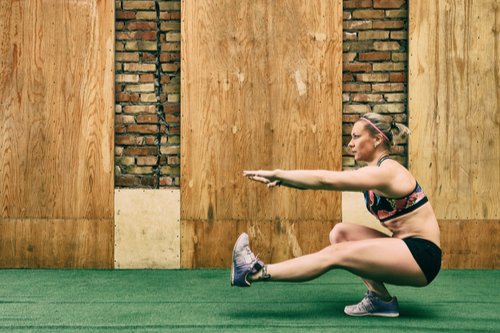
If you’ve been sticking around for a long time, you know the concept of the “Big Six”, the 6 most effective muscle building exercises in strength training.
Most of these exercises are performed with weights, i.e. barbells or dumbbells.
In this section you will learn how you can easily transfer the concept of the Big Six to training with your own body weight.
First of all, each of these fitness exercises at home must meet four criteria:
- The exercise is functional. That means, it maps everyday movement patterns.
- It uses as much muscle mass as possible at the same time.
- There are multiple joints involved in the movement.
- You need a lot of energy to perform them.
Now let’s take a closer look at which exercises you can use to train the Big Six.
In the following table you can see examples of exercises for all six movement patterns – with a barbell, with dumbbells, on the machine or with your own body weight.
There are a number of possible bodyweight exercises for each of the six movement patterns. Here are a few more examples:
- Squats: Squats, pistol squats, sumo squats, skater squats.
- Lunges: Lunge backwards, lunge forward, side lunges, Bulgarian split squat.
- Deadlifts: Standing scale, hip thrust, bridge, one-leg hip thrust, one-leg bridge.
Push: Push-ups, diamond push-ups, handstand push-ups, one-arm push-ups, pike push-ups, dips.
- Pull: Pull-ups, L-seat – Pull-ups, crawling, reverse rowing (at the table), towel rowing, muscle-up.
- Trunk rotation: Reverse crunch, lower body Russian twist, abdominal lifts, leg raises while lying down , side plank.
Incidentally, Paul Wade pursues a similar concept in his excellent book “Trainieren wie im Knast”.
Despite all the variety of exercises, training with your own body weight still presents us with a problem that we do not have with dumbbell training:
When we move on to the next heavier exercise, the resistance often increases suddenly.
This doubles the resistance you are working against when transitioning from the regular squat to the one-legged squat (pistol squat).
We solve this issue by using a trick and changing the exercise itself.
In the following section I will introduce you to five ways in which you can make a bodyweight exercise easier or harder.
5 ways to change the “weight” in bodyweight exercises
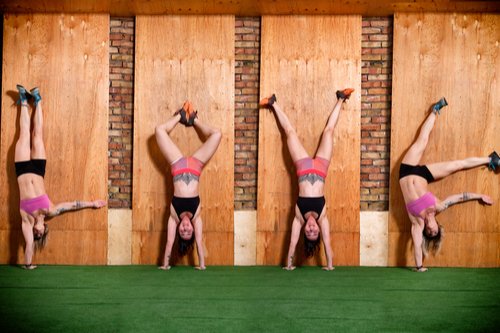
There are a total of five ways in which you can make an exercise heavier or lighter and thus put the principle of continuous overload into practice.
Of course you can also combine the techniques with each other to achieve an optimal training effect.
1. You change the lever
By shifting your body’s center of gravity, you can change the lever and thus the resistance against which your muscles work.
By raising your legs while doing a push-up and placing them on a bench instead of the floor, your arms have to do more work.
If you can change the lever during an exercise, you should use this option to get into the rep range that is ideal for your training goal. For example 8-12 repetitions per set if you want to build muscle or lose fat.
2. You change the amplitude of movement
By using the full range of motion of your joints, you increase the intensity of an exercise. Conversely, an exercise becomes easier if you limit its range of motion.
Touching the floor with your nose during a push-up is therefore much more strenuous than only half-lowering your body.
Nevertheless, for every exercise you should aim to get closer and closer to the full range of motion and to reach it at some point.
3. You vary the practice speed
Here we are back to the principle of the optimal speed:
- The slower you do an exercise, the higher the intensity.
- The faster you do an exercise, the lower the intensity.
With the same Number of repetitions, mind you.
That’s why Mark performed his 2013 push-ups in 24 hours at a very high speed.
4. You perform the exercise unilaterally
The supreme discipline of a bodyweight exercise is often its unilateral (one-sided) counterpart.
So, pistol squats, one-arm pull-ups or one-arm push-ups.
With the same leverage, you double the resistance by transitioning from the regular (bilateral) to the unilateral variant.
5. You use training methods and intensity techniques
Training methods and intensity techniques in strength training are a separate chapter.
You have already learned about the method of “decreasing rates” above. Mark has presented other muscle building training methods, many of which you can transfer one-to-one to training with your own body weight.
By shortening the breaks in sentences, you can further increase the intensity of an exercise.
Okay, enough theory. Let’s get into the implementation in the next section.
Example: 13 ways to change the resistance during push-ups
The example of “push-ups” shows how diverse you can dose the resistance of an exercise.
Only two of the 5 ways are used in this example, No. 1 (lever) and No. 4 (both sides vs. one side).
The resistance increases continuously from the first to the 13th level – from easy to rock-hard:
- Level: Push-ups against the wall
- Level: Push-ups with your hands on a chest-high support
- Level: Push-ups with your hands on a waist-high support
- Level: push-ups with your hands on a knee-high support
- Level: Classic push-up on the floor
- Level: Push-up, legs slightly raised
- Level: Push-up, legs knee-high
- Level: One-armed Push-ups, one hand on the ball (the other on the floor)
- Level: One-armed push-up, one hand on the table (the other on the back)
- Level: One-armed push-up, one hand up knee-high support
- Level: one-armed push-up, on the floor
- Level: one-armed push-up, legs slightly raised
- Level: one-armed push-up, legs knee-high
Tip: By lifting one leg, you can make the exercise more difficult and add additional steps. There are (almost) no limits to your imagination.
Get started! With this training plan you start your transformation

The best training plan is useless if you don’t implement it. That is the point that I unfortunately cannot relieve you of.
But what an effective training plan looks like, with which you can get started right away, I’ll show you now.
There is one point to keep in mind:
Physical change takes place on several levels.
The M.A.R.K. The formula gets to the point: It always starts with knowing where you want to go: Define your goal. And a healthy diet also plays a crucial role.
Then come your muscles: Now you can adapt the bodyweight exercises to your goals in such a way that they neither over- nor under-demand you.
The individual adaptation of your training plan is perhaps the most important success factor in bodyweight training.
Because that’s what everything we’ve discussed so far comes down to:
You set an EFFECTIVE training stimulus to provoke your body to adapt.
Okay, let’s get into action. Here are two training plans: one for beginners and one for advanced.
Bodyweight training plan – for beginners and advanced
Do each of the three workouts once a week. Advanced users can also train four times a week.
Each training day consists of four bodyweight exercises that are completed in 20-30 minutes.
You should distribute the training days as evenly as possible over the week.
Choose the difficulty of the exercise so that you stay within the given rep range.
The name of the exercise is a generic term that represents the variant that suits your current training level.
Most beginners shouldn’t do a handstand push-up, but rather the simplest variant of this exercise: simple overhead press with hips bent against a wall.
You take a break of 60 seconds between each training set.
Bodweight Workout – Day A
Pull-ups
Beginners:
1-2 sentences, 15-20 reps.
Advanced:
3-4 sets,
8-12 reps.
Pushups
Beginners:
1-2 sentences, 15-20 reps.
Advanced:
3-4 sets,
8-12 reps.
Squat
Beginners:
1-2 sentences, 15-20 reps.
Advanced:
3-4 sets,
8-12 reps.
Leg lifter
Beginners:
1-2 sentences, 15-20 reps.
Advanced:
3-4 sets,
8-12 reps.
Bodweight Workout – Day B
Handstand push-ups
Beginners:
1-2 sentences ,
15-20 reps.
Advanced:
3-4 sets,
8-12 reps.
Bridge
Beginners:
1-2 sentences, 15-20 reps.
Advanced:
3-4 sets,
8-12 reps.
Pull-ups
Beginners:
1-2 sentences, 15-20 reps.
Advanced:
3-4 sets,
8-12 reps.
lunges
beginners:
1-2 sentences, 15-20 reps.
Advanced:
3-4 sets,
8-12 reps.
Bodweight Workout – Day C
Pushups
Beginners:
1-2 sentences, 15-20 reps. Advanced:
3-4 sets,
8-12 reps.
Leg lifter
Beginners:
1-2 sentences, 15-20 reps. Advanced:
3-4 sets,
8-12 reps.
Handstand push-ups
Beginners:
1-2 sentences ,
15-20 reps.
Advanced:
3-4 sets,
8-12 reps.
Bridge
Beginners:
1-2 sentences, 15-20 reps.
Advanced:
3-4 sets,
8-12 reps.
I recommend beginners to stay in strength endurance training for at least four to six weeks before they feel their way into the “muscle building” area with less than 15 repetitions. It is important that you log your progress and change something if the feedback deviates from your goal.
You can find a comprehensive overview description of the exercise variants in all levels of difficulty in the following two book tips.
Book tips: More about training with your own body weight
This article gives you an initial overview and the tools you need to get started today. If you want to stay tuned and learn more about the topic, I recommend reading the following two books.
1. Paul Wade – Train like in jail
Paul Wade’s classic “Convict Conditioning” is also available as a German translation with the title “Training like in prison” for all those who don’t like English. The exercise descriptions are very detailed, so that the training program can also be carried out safely for beginners.
And if you want to keep exercising with your own body weight, Paul Wade also goes into how you can get fit for pistols, one-arm push-ups, handstands and pull-ups.
If you are (or want to become) a strength athlete, you will benefit from the information in this book. The workout programs are varied and promise a lot of fun.
2. Pat Bauer – P.A.T. Bodyweight Training
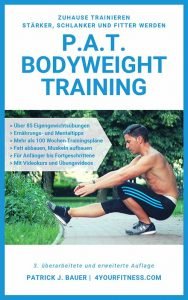
Some shameless self-promotion is allowed at this point. After all, it’s about helping you with training with your own body weight.
If you like this article, then my ebook “P.A.T. Bodyweight Training ” the ideal continuation for you. This not only tells you why you should use your own body weight training.
I also take you by the hand and show you more than …
- 80 exercises adapted to your fitness level and
- 40 weeks of sample training plans
… how you can sustainably transform your body through training with your own body weight.
P.A.T. By the way, it only stands for my name, but also for “personally adaptable training”. You will learn how to adapt bodyweight exercises perfectly to you and your goals.
True to the motto: “Be strong! You never know who you might be inspiring! ”
Sounds interesting? You can buy my ebook here.
Conclusion
You now know the secrets of training with your own body weight and know how to use it to sustainably transform your body.
After all, you can really challenge your muscles without equipment and without a gym if you consider two things:
- You follow the 7 principles of success of the “right” strength training and transfer them to bodyweight training.
- You are training the “Big Six”, all six basic muscle building -Motion patterns.
You now know how to do both.
The crucial point is that you now take the next step and get into action. For example with the training plan above.
The individual adaptation of your training plan is perhaps the most important success factor. Then you set an effective training stimulus – and your body begins to change towards your goal.
I wish you every success and, above all, a lot of fun!

